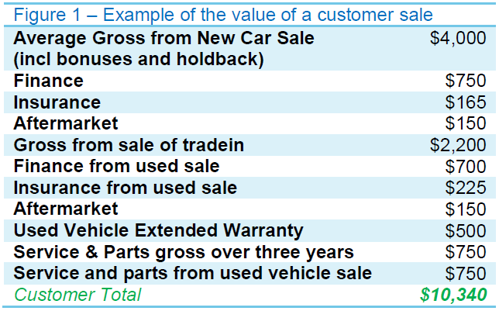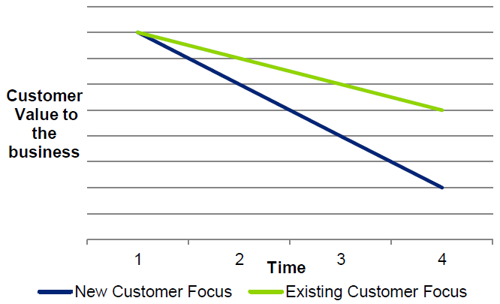
Your customers and you
Deloitte Motor Industry Services | 16 February 2012
Unlocking the Value of your Customers
Everyone would agree that customers are the lifeblood of our businesses. But do we setup our businesses around our customers? After all, without them, we have no business.
In a Dealership, we have two types of customers – existing customers and prospective customers.
Traditionally we try to grow our business by directing our marketing budgets and strategies towards activities that entice prospective customers to our businesses. Marketing to existing customers has been at a lower level and not always strategically planned. Over recent years, there has been greater recognition within the industry towards looking after our existing customers (CRM).
Nonetheless, as a Dealership you need to ask yourself these two questions:
- Have we got the advertising mix right between capturing and keeping customers?; and
- Are we really getting the value out of our existing customer base?
We should never forget that we spent money attracting our existing customers. They were once prospective customers. We already have a sunk cost in marketing from attracting them to the business, and if we don’t look after them they will become ex-customers on whom we need to spend even more funds to regain (hopefully). More importantly, with the advent of the internet and social media, our existing customers have even more impact on our business - if we upset them they are likely to tell everyone in their virtual world!
Identify your marketing strategy
Your marketing budget in the Dealership should focus on two areas:
- Acquiring New Customers
- Retaining existing customers
When you review your marketing budget, how much is focused on each area? Are you spending too much money on acquiring customers rather than marketing to your existing customers? Particularly when it is known that existing customers are worth more to you over the long term (refer to Figure 1). Often we are too focused on prospecting for new customers that we neglect to look after our existing customers or even check if we have other products they might be interested in.

You need to consider whether your marketing strategy, time and budget is too focused on selling to new customers and you end up neglecting existing ones and develop strategies to look after existing customers. Often it is easier to book the marketing time and media than it is to develop and implement a customer strategy.

For example, a customer both purchased and financed a vehicle from the Dealership. Do we target them specifically for other products and services after they purchased the vehicle? For instance, in your regular email marketing to customers do you mention the good deals on aftermarket products or accessories that are available for the vehicle(s) they purchased? If they couldn’t afford a premium extended warranty on a used car at time of purchase, do we offer it to them at a later date when the funds may be available to them. If they didn’t insure their vehicle through the Dealership do we contact them after 11 months offering them a deal on insurance?
By keeping in contact with the customer at appropriate time intervals and delivery methods, we can optimise our ability to do business with them, keep them as a happy customer and continue selling them products.
Ask yourself this – Do you have someone at your Dealership who keeps track of what products you sold a customer and what they didn’t buy? Business shouldn’t stop with the sale or service of a car. They are already a customer and if they are happy why wouldn’t they continue to deal with your business. Consider having a matrix by customer of what products they bought – by default you have a list of potential sales and marketing opportunities with the products and services that they didn’t buy.
Even if they aren’t in your area for service, what else can you do to increase the value of the relationship? There must be other items in your product and service portfolio that they might be interested in.
Often when dealerships react to a bad market or economy and slash their marketing budget, one of the first areas hit is the CRM area. This should be the last area hit – protect your existing customers as they are far more valuable than your prospective customers. In fact, placing marketing funds here should have a greater return on investment for the business.
Customer service personnel in a Dealership shouldn’t be considered a cost centre. Utilised effectively, they are a profit centre – keeping customers and identifying the opportunities to increase your business with your existing clientele.
Track your customers
Do you actively manage and maintain your customer database? At Dealerships you work hard to obtain the initial satisfied customer, only to notice sometimes that another company has stepped in to steal them, e.g., independent service repairers.
As a business, do you know if you have lost a customer, but more importantly do you have a process in place to find out why – and even to attempt to get them back? Make it your business to know why each customer has left the business –even the prospective customers.
“The Customers that we already have are far more valuable to us then the customers we hope to have”
The Culture of CRM
Good CRM is not just about jargon, marketing dollars or even having a call centre, It is about looking after the customer at all points along the contact curve. It requires everyone in the business to live the culture of looking after the customer; knowing that then the customer will look after them. Implemented effectively, it is almost like a religion. Every customer touch point is an opportunity to further build on the relationship.
Customers and social media
At Deloitte we would recommend that you consider having a social media strategy as it is one of the most effective ways to interact with the Generation Y customer.
The internet is now a part of our everyday life and social media is heading in the same direction – whether we like it or not. In this situation it is too risky NOT to focus on and look after our existing client base. Should you give them reason not to be happy with your Dealership; you need to understand that their entire virtual network of “friends” will also know.
Should you currently not have this in place, then we would also recommend that you implement a process to regularly search through online sources for comments in relation to your Dealership, whether positive or negative. If you are not aware of negative reviews or feedback, you do not have the opportunity to try and rectify the problem.
Conclusion – your customers and you
The customers that you currently have:
- Have the power to decide whether they will continue to do business with you
- The power to decide how much money they will spend with you
- The power of word of mouth
As a business, your Dealership should have a plan in place to:
- Gain additional ongoing business from each customer – long-term relationship;
- Garner extra business from each customer – Cross-sell
- Obtain either direct or indirect referrals from satisfied customers – client relationship.
“We need to turn a first-time customer (conquest) into a long term, value add customer”
And do you understand the customer lifecycle from their point of view? What are their key points in vehicle ownership – purchase, insurance, service, accident repair, fuel, finance, end of finance term, insurance renewal, sale and purchase of next vehicle, end of warranty.
Looking after customers’ needs to be an on going, proactive part of the business for every staff member. But to do so, the business needs the culture, time, budget and strategy to do so. Have you got your strategy in place?
- Learn about your customers
- Understand the customer lifecycle from their point of view. What are their key points in vehicle ownership – purchase, insurance, service, accident repair, fuel, finance, end of finance term, insurance renewal, sale and purchase of next vehicle, end of warranty.
- Utilise the marketing channel that the customer uses
- “Relevant” marketing content that is of interest to them, not necessarily of interest to us. Customers sometimes get too much information – communicate in a way that customers are happy with and that is relevant to them!
- Make them feel valued.
General Information Only
This presentation contains general information only, and none of Deloitte Touche Tohmatsu Limited, its member firms, or their related entities (collectively the “Deloitte Network”) is, by means of this presentation , rendering professional advice or services.
Before making any decision or taking any action that may affect your finances or your business, you should consult a qualified professional adviser. No entity in the Deloitte Network shall be responsible for any loss whatsoever sustained by any person who relies on this presentation.
About Deloitte
Deloitte refers to one or more of Deloitte Touche Tohmatsu Limited (“DTTL”), its global network of member firms, and their related entities (collectively, the “Deloitte organization”). DTTL (also referred to as “Deloitte Global”) and each of its member firms and related entities are legally separate and independent entities, which cannot obligate or bind each other in respect of third parties. DTTL and each DTTL member firm and related entity is liable only for its own acts and omissions, and not those of each other. DTTL does not provide services to clients. Please see www.deloitte.com/about to learn more.
Deloitte Asia Pacific Limited is a company limited by guarantee and a member firm of DTTL. Members of Deloitte Asia Pacific Limited and their related entities, each of which are separate and independent legal entities, provide services from more than 100 cities across the region, including Auckland, Bangkok, Beijing, Hanoi, Hong Kong, Jakarta, Kuala Lumpur, Manila, Melbourne, Osaka, Seoul, Shanghai, Singapore, Sydney, Taipei and Tokyo.
This communication contains general information only, and none of Deloitte Touche Tohmatsu Limited (“DTTL”), its global network of member firms or their related entities (collectively, the “Deloitte organization”) is, by means of this communication, rendering professional advice or services. Before making any decision or taking any action that may affect your finances or your business, you should consult a qualified professional adviser.
No representations, warranties or undertakings (express or implied) are given as to the accuracy or completeness of the information in this communication, and none of DTTL, its member firms, related entities, employees or agents shall be liable or responsible for any loss or damage whatsoever arising directly or indirectly in connection with any person relying on this communication. DTTL and each of its member firms, and their related entities, are legally separate and independent entities.

